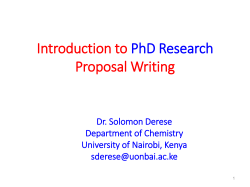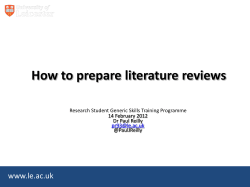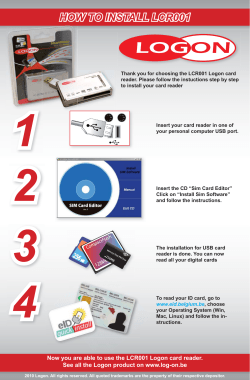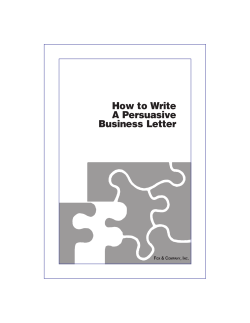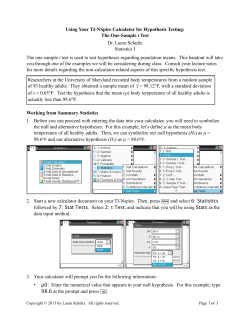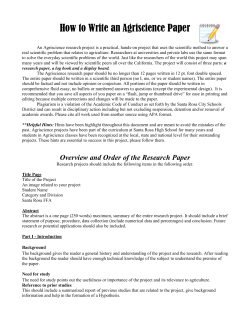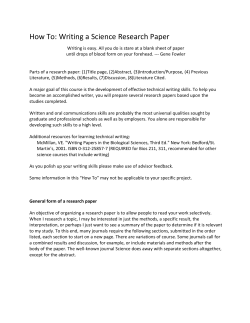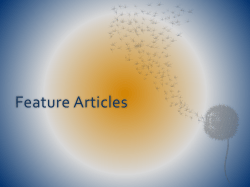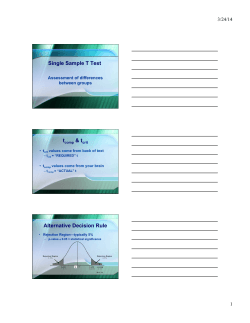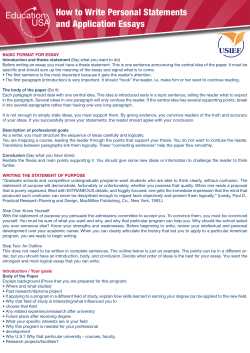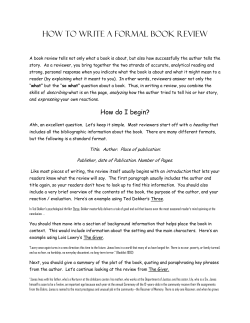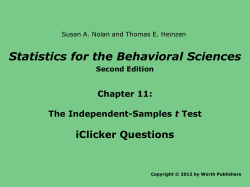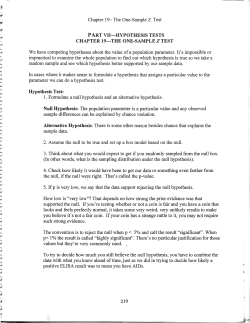
How to write-up a lab report C81MPR Practical Methods (Lab 3)
C81MPR Practical Methods (Lab 3) How to write-up a lab report Jonathan Stirk & Danielle Ropar About Laboratory Reports The writing of laboratory reports is an essential part of the practical course One function of this course is to give you practice and feedback about how to write such reports. What are Lab Reports For? The purpose of a lab report is: – to communicate to others what you did – To explain why you did it – To describe how you did it – To present what you found – To say what you think it means About the Format of a Lab Report It is essential to follow a standard format – This allows the reader to locate the information that he or she requires immediately without having to work through the entire report The simple rule for report writing is: – Could someone replicate your experiment with the information you have provided? The Format of a Lab Report • Your task in the report is to tell your reader all about the study you conducted • The main sections of the report should be as shown on the right Title Abstract Introduction Method – Design – Subjects – Apparatus & Materials – Procedure Results Discussion References Title The title should be concise yet clear enough to give the reader an idea of the investigator's central concerns The most common type of title states only the dependent and independent variables – Remember that your reader will initially see the title and nothing else, but wishes to know whether or not the report is relevant to his/her research interests – Your title should be a brief, but accurate reflection of the content of the report Abstract The abstract is a self-contained and brief summary of the main points of the write-up It should contain: – a brief statement of the problem being investigated – the design used – the subjects investigated – the stimulus materials involved and any important apparatus – the principal results obtained and their analysis – the main conclusions drawn How Long is an Abstract? You should aim for abstracts which are approximately 100 words long – A quick rule of thumb is to take a summary sentence from each section of the report. The abstract is much easier to write if you make it the last thing that you write even though it appears at the beginning of the write-up Introduction The introduction should present the reasoning behind the particular experiment which you are describing. This means that the reader, having read all the introduction, should be able to predict what your experiment will be What to Include in the Introduction? Essentially in the introduction to your report you should provide the following information in the following order: – Review the background material (existing findings and theories) relevant to your study – Outline the precise problem you chose to investigate and the way in which you investigated it – Outline the results predicted by your research hypothesis (hypotheses) Method The method must contain enough information for the reader to be able to repeat the experiment. The method section is split into the subsections – – – – Design Subjects Apparatus & Materials Procedure Design In the design section you must state the following: – The type of design you used (e.g. between, within, mixed or matched subjects) – The independent variable(s) including the conditions you selected to represent different levels of the IV – The dependent variable including details of the units of measurement used (e.g. seconds, milliseconds, or number of correct responses) – What the experimental hypothesis was Subjects This should state: – – – the number of subjects used how they were selected any other important characteristics mean age, age range number of male and female participants educational level Occupation etc Apparatus & Materials The apparatus will often consist of simple items such as a stopwatch – If complex equipment has been used (e.g., a computer running special software), you should describe it in sufficient detail to allow equivalent apparatus to be used The materials used in the experiment are the stimuli – Words, puzzles, questionnaires, etc are materials You should describe the general criteria used to select the particular materials Procedure This section describes how the design was actually implemented and should describe exactly what the subjects and experimenters did with the apparatus and materials This will include a description of the instructions given to subjects – Any particular emphasis (e.g. as regards speed and accuracy) should also be mentioned There should be enough information for someone to repeat your experiment exactly Results This section provides the reader with a clear, concise summary of the data you collected and the results of any statistical tests This section reports the data and their analysis – it does not interpret the results which is left to the discussion section Tables & Figures Tables and figures should all be titled, and care should be taken to label them clearly – The reader should not have to refer to the text to understand your tables and figures – However, you must include some explanatory text describing what data appears in the table A step by step guide to the results section Present a summary table/s of the results including appropriate measures of: – central tendency (mean, median or mode) – dispersion (standard deviation, variance, range) If meaningful use graphs Report the statistical analysis conducted on the data – – – – – the value of the test statistic degrees of freedom (or number of subjects) one- or two- tailed test the observed p-value whether the test result was significant If a significant finding was observed state the direction of the effect Discussion This is the section in which you can interpret the results of the experiment and discuss their meaning – It is important that your discussion relates the results to the issues raised in the Introduction The results may not have led to clear-cut answers to the questions raised initially – Your discussion might have to suggest further experiments which can now be seen to be necessary for answering the initial question – You might also discuss any limitations of the experiment that have come to light, but which were not predicted in advance Stages to writing a discussion State what the results are by providing a précis (in words) of the results Account for the findings Explore the implications of the findings Stating the results You should open the discussion by summarising the main features of the results: – Was there a significant difference between the experimental conditions? – If so, in what direction? – Were the findings consistent with the experimental hypothesis? Accounting for the findings The next stage is to discuss what the findings mean If you have rejected the null hypothesis then – you need to establish whether this was really caused by the manipulation of the independent variable – you need to make sure that no other confounding variables or experimental artefacts can be said to be the cause of the outcome of the experiment If you have failed to reject the null hypothesis – you need to convince the reader that the only plausible explanation for this is the absence of a cause and effect relationship between the independent and dependent variable Failing to Reject the Null Hypothesis This is not an opportunity to try and prove the null hypothesis A failure to find a significant difference is just a failure to find a significant difference It does not mean that you can conclude that there was no difference You can only conclude that there was no evidence of a difference Were the Findings consistent with the research hypothesis? Yes – What have we learned about the relationship between the independent and dependent variables? – Does this new understanding allow us to improve our theories or our explanations of particular phenomena? No – If there were any specific limitations to your study then they should be used to: motivate further research decide between alternative explanations Essentially your job is to show how the study you have conducted has benefited the research community and improved our understanding of the ideas that you introduced earlier References When writing references we distinguish between – Primary Sources (ones you have actually read) – Secondary Sources (ones you have cited but not actually read) Further information can be found on the web pages associated with writing lab reports Marking Scheme When assessing the practical reports the markers consider five broad issues: – Content (does the report suitably motivate, justify, analyse and evaluate the conducted research?) – Global Structure (does the report adhere to the format specified in the School’s document on writing reports?) – Local Structure (does each section of the report contain the relevant information?) – Reasoning (is there a convincing line of argument for the research conducted and a suitable conclusion drawn?) – Evaluation of evidence (is the relevant literature evaluated appropriately?) Further Information A good book – Andy Field & Graham Hole (2003). How to design and report experiments. Sage: London. Chapter 9, p. 287 onwards – See bottom of Practicals Webpage http://www.psychology.nottingham.ac.uk/cou rses/modules/info/c81mpr.html
© Copyright 2025
